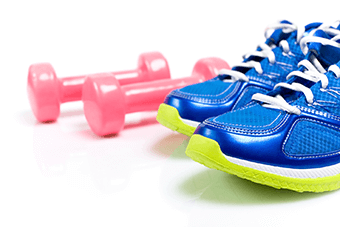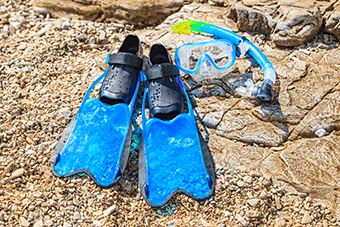Plastics have revolutionised sports in recent years. From the tracks on which Olympic athletes pursue new records to the shoes, clothing and safety equipment they wear and the stadia they perform in, modern sports rely on plastics. In addition to delivering the performance characteristics that modern athletes demand, plastics also provide sustainability benefits. For example, the Maracanã stadium at the Rio 2016 Olympics used millions of recycled plastic bottles to produce more than 6,700 seats in the stadium. In addition, the ribbons on the medals awarded to athletes were made of 50% recycled plastic bottles.
Plastics in ballgames
 Plastic materials are used in almost all ballgames. Thanks to plastics, football for instance has become faster and more technical than ever. Modern ball production relies on the thermal bonding of a polyurethane layer on a seamless glued surface, which delivers excellent responsiveness and ball contact sensitivity, a predictable trajectory, substantially reduced water uptake, and maximum abrasion resistance. In addition, referees’ whistles, goal nets, corner flags, shin pads, football boots and jerseys are all made with plastics.
Plastic materials are used in almost all ballgames. Thanks to plastics, football for instance has become faster and more technical than ever. Modern ball production relies on the thermal bonding of a polyurethane layer on a seamless glued surface, which delivers excellent responsiveness and ball contact sensitivity, a predictable trajectory, substantially reduced water uptake, and maximum abrasion resistance. In addition, referees’ whistles, goal nets, corner flags, shin pads, football boots and jerseys are all made with plastics.
Plastics in sports footwear
 Running shoes that weigh just a few grams and yet provide the strength and suppleness that athletes demand as they power out of the running blocks can make the difference between victory and defeat. Plastics play an important role in today’s sports shoe designs, whether the application is running, jumping or hiking. Take hiking boots for example; the lining and tongue can be made from a loosely woven polyester fabric that repels water and allows moisture to rapidly evaporate from the boot’s exterior, keeping the hiker’s feet dry in the wet and cool in the heat. For comfort and support, the mid-sole can be made from ethyl vinyl acetate (EVA), which provides lightweight cushioning. And polyester foam padding is used to provide extra comfort on the insoles.
Running shoes that weigh just a few grams and yet provide the strength and suppleness that athletes demand as they power out of the running blocks can make the difference between victory and defeat. Plastics play an important role in today’s sports shoe designs, whether the application is running, jumping or hiking. Take hiking boots for example; the lining and tongue can be made from a loosely woven polyester fabric that repels water and allows moisture to rapidly evaporate from the boot’s exterior, keeping the hiker’s feet dry in the wet and cool in the heat. For comfort and support, the mid-sole can be made from ethyl vinyl acetate (EVA), which provides lightweight cushioning. And polyester foam padding is used to provide extra comfort on the insoles.
Plastics in tennis
 Today, sports manufacturers use plastics to make tennis racquets that are light and strong, with excellent shock-absorbing systems. As a result, players now have more powerful racquets with increased ease of manoeuvrability. In some racquet models, the central longitudinal strings are lead through a specially developed plastics core that is embedded in a plastics composite, which reduces shock vibration by 45% when the ball hits the racquet. This innovative technology allows tennis enthusiasts at all levels to enjoy the benefits of plastics on their local courts.
Today, sports manufacturers use plastics to make tennis racquets that are light and strong, with excellent shock-absorbing systems. As a result, players now have more powerful racquets with increased ease of manoeuvrability. In some racquet models, the central longitudinal strings are lead through a specially developed plastics core that is embedded in a plastics composite, which reduces shock vibration by 45% when the ball hits the racquet. This innovative technology allows tennis enthusiasts at all levels to enjoy the benefits of plastics on their local courts.
Plastics in watersports
 The mouldability of composite plastics enables sleek dynamic hulls to be produced that are low in weight and high in strength. Power cruisers, sailing yachts and almost every other vessel now has a hull, deck, superstructure and even a mast made of composites. Today’s yachts use advanced carbon fibre compounds that take yacht racing to a new level. This innovative plastic compound has largely replaced traditional materials and provides greater flexibility, superior performance and faster production. Smaller craft such as kayaks, canoes and surfboards also rely on the unique properties of plastics to achieve outstanding performance.
The mouldability of composite plastics enables sleek dynamic hulls to be produced that are low in weight and high in strength. Power cruisers, sailing yachts and almost every other vessel now has a hull, deck, superstructure and even a mast made of composites. Today’s yachts use advanced carbon fibre compounds that take yacht racing to a new level. This innovative plastic compound has largely replaced traditional materials and provides greater flexibility, superior performance and faster production. Smaller craft such as kayaks, canoes and surfboards also rely on the unique properties of plastics to achieve outstanding performance.
Plastics in winter sports
 Plastics are omnipresent in modern winter sports and often provide the decisive edge that means the difference between first and second place. From alpine skiing to biathlon and toboggan, the athlete and the equipment both have to deliver top performance. As a result, no winter sports equipment, clothing or shoes can do without plastics. This is just as true for the casual participant as it is for the Olympic athlete.
Plastics are omnipresent in modern winter sports and often provide the decisive edge that means the difference between first and second place. From alpine skiing to biathlon and toboggan, the athlete and the equipment both have to deliver top performance. As a result, no winter sports equipment, clothing or shoes can do without plastics. This is just as true for the casual participant as it is for the Olympic athlete.
Plastics and children’s sport and leisure goods
 For more than 50 years, the world's toymakers have been using plastics to make some of the best known and most popular toys, sports and leisure goods for children. From bicycle helmets and flotation devices to knee protectors and other protective sporting gear, plastics help children to have fun and keep safe every day. Like all plastics, these materials are thoroughly tested, well-researched, durable, flexible and cost-efficient.
For more than 50 years, the world's toymakers have been using plastics to make some of the best known and most popular toys, sports and leisure goods for children. From bicycle helmets and flotation devices to knee protectors and other protective sporting gear, plastics help children to have fun and keep safe every day. Like all plastics, these materials are thoroughly tested, well-researched, durable, flexible and cost-efficient.
Contact us for more information
Contact us for more information about the benefits of plastics and the activities of PlasticsEurope.














